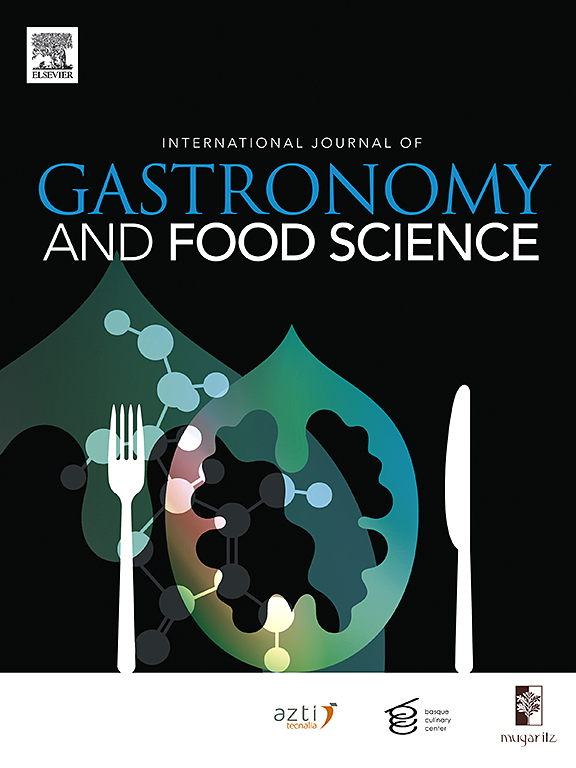评估酥皮糕点食品模型的烹饪质量:豆科面粉的化学和功能特性的影响
IF 3.6
2区 农林科学
Q2 FOOD SCIENCE & TECHNOLOGY
International Journal of Gastronomy and Food Science
Pub Date : 2025-06-06
DOI:10.1016/j.ijgfs.2025.101219
引用次数: 0
摘要
在欧洲,豆类消费仍低于建议水平,需要发展当地生产系统,以帮助改善人类健康并加强应对全球变暖的斗争。美食的方法提供了一种展示豆类的原始方式,同时也突出了它们的主要功能和感官品质。这项研究集中在五种豆类——白豆、红豆、鹰嘴豆、绿扁豆和羽扇豆——未经处理或热处理后加工成面粉。专业厨师被要求制作一份以豆类为基础的酥皮糕点食谱,随后将其简化为一种食材较少的食物模型,以尽量减少食材之间的相互作用。对面粉的化学成分和功能进行了评估,同时对面团的质地以及脆皮糕点的最终质地和感官质量进行了评估。面粉的化学成分、吸水吸油能力、粒度和颜色差异显著(p值<;0.05)。因此,在不同的豆类酥皮糕点中可以看到明显的差异。纤维含量与面粉吸水能力和面团硬度呈正相关,导致酥皮糕点易碎。用豆科面粉制成的酥皮糕点与用其他豆类面粉制成的酥皮糕点具有非常不同的特征,这是由于纤维、蛋白质和脂质含量的显著差异。此外,使用由经过热处理的豆类制成的面粉可以显著降低酥皮糕点的硬度。通过感官分析证实了基于仪器的纹理结果。食物模型可以帮助预测豆科面粉的化学特性如何影响酥皮糕点的烹饪质量。这些知识可以指导豆类在特定食品中的应用。本文章由计算机程序翻译,如有差异,请以英文原文为准。

Assessing the culinary qualities of a shortcrust pastry food model: Impact of the chemical and functional characteristics of legume flours
In Europe, legume consumption remains below recommended levels, and local production systems need to be developed to help improve human health and bolster the fight against global warming. A gastronomic approach provides an original way of showcasing legumes while also highlighting their main functional and sensory qualities. This study focused on five legumes—white beans, red beans, chickpeas, green lentils, and lupins —that were untreated or thermally treated and processed into flours. Professional chefs were asked to create a legume-based shortcrust pastry recipe, which was subsequently simplified into a food model with fewer ingredients to minimize ingredient interactions. The chemical composition and functionality of the flour were assessed, along with the dough texture and the final textural and sensory qualities of the shortcrust pastries. The flours differed significantly in chemical composition, water/oil absorption capacity, particle size, and color (p-value <0.05). Consequently, marked variation was seen among the different legume-based shortcrust pastries. Fiber content was positively associated with both flour water absorption capacity and dough hardness, resulting in crumbly shortcrust pastries. Shortcrust pastries made with lupin flour had very different characteristics than shortcrust pastries made with the other legume flours, due to pronounced differences in fibre, protein, and lipid contents. Additionally, using flours made from thermally treated legumes significantly decreased shortcrust pastry hardness. Instrument-based textural results were confirmed through sensory analysis. The food model can help predict how the chemical characteristics of legume flours affect shortcrust pastry culinary quality. This knowledge can orient legume use in specific food applications.
求助全文
通过发布文献求助,成功后即可免费获取论文全文。
去求助
来源期刊

International Journal of Gastronomy and Food Science
Social Sciences-Cultural Studies
CiteScore
5.30
自引率
10.50%
发文量
170
审稿时长
45 days
期刊介绍:
International Journal of Gastronomy and Food Science is a peer-reviewed journal that explicitly focuses on the interface of food science and gastronomy. Articles focusing only on food science will not be considered. This journal equally encourages both scientists and chefs to publish original scientific papers, review articles and original culinary works. We seek articles with clear evidence of this interaction. From a scientific perspective, this publication aims to become the home for research from the whole community of food science and gastronomy.
IJGFS explores all aspects related to the growing field of the interaction of gastronomy and food science, in areas such as food chemistry, food technology and culinary techniques, food microbiology, genetics, sensory science, neuroscience, psychology, culinary concepts, culinary trends, and gastronomic experience (all the elements that contribute to the appreciation and enjoyment of the meal. Also relevant is research on science-based educational programs in gastronomy, anthropology, gastronomic history and food sociology. All these areas of knowledge are crucial to gastronomy, as they contribute to a better understanding of this broad term and its practical implications for science and society.
 求助内容:
求助内容: 应助结果提醒方式:
应助结果提醒方式:


